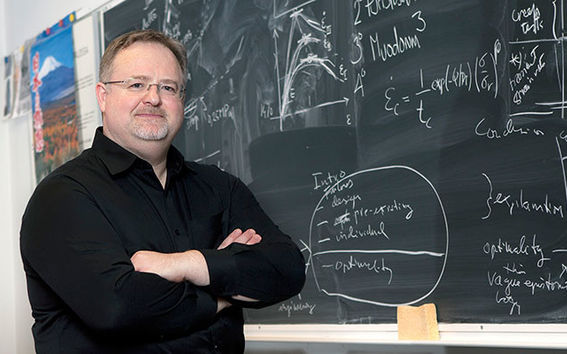A new approach to designing structures

Toni Kotnik’s professorship is in design of structures. The professorship is a joint position between the Department of Architecture at the School of Arts, Design and Architecture and the Department of Civil Engineering at the School of Engineering.
- One of my main tasks is to build a bridge between architecture and structural engineering. My aim is to strengthen the connection between these two disciplines, Kotnik says.
According to Kotnik, architects and engineers do not usually discuss the design of structures enough or early enough, which often leads to problems.
- Architects traditionally look at matters from a more artistic perspective, while engineers approach the subject scientifically. I attempt to create the thinking and tools that make it possible for designers to take into account the physical requirements of structures while they consider the design.
Through his professorship, Kotnik wants to encourage architects to take advantage of scientific expertise in engineering. On the other hand, civil engineers should pay more attention to the significance of design and planning structures in creating our cultural environment.
- Both architects and engineers have an influence on what kind of shape our environment takes. As a consequence, both groups also have a certain responsibility.
Focusing on mathematics
According to Kotnik, a lack of collaboration between architects and engineers is not a problem only in the field of building in Finland.
- We may speak highly of collaboration, but in practice there is very little of it. With respect to futur sustainable development of our built environment there is an increasing need for collaboration between different disciplines.
- Sustainable development is not the responsibility of politicians or an individual discipline, , only. Representatives from different sectors must cooperate to solve the problems that we face in built environments, especially in cities.
Kotnik outlines sustainable future building methods that will use novel ‘hybrid elements’ instead of the current mono-functional standard building elements that have been manufactured in factories.
- Hybrid elements can have many functions and they can be used to solve architectural problems. In addition to supporting structures, elements can also be used at the same time in creating shade, heating, cooling and ventilation.
Nature provides a lot of examples of multifunctionary elements. Hybrid elements can be compared with the trunk of a tree. The trunk has cells and pores that transport liquids, function as storage areas and support the tree.
- In order to see the possibilities provided by multifunctional elements, we have to improve our understanding of the connection and interaction between material and form as well as of how a material system can be used to serve the ideas in architecture.
Kotnik draws a complicated diagram to help him explain his thinking. Mathematics is the key to everything.
- Mathematics is not merely a means to perform technical calculations. Mathematics provides a tool for conceptual thinking. We can use it to organise, structure and make models. Mathematics is a language that we can use to join expertise from different disciplines.
A long way to go
Kotnik teaches structural design to new bachelor’s students as well as to students studying the master’s programme.
- Adopting new thoughts and approaches is demanding and therefore it is wise to start the teaching and discussions early on during bachelor’s studies.
Master’s students were taught in the subject on the Design studio courses last autumn. In principle, the exercises were rather simple.
- For example, the students were moving two lines that they had drawn. At the same time, they observed how spatial dynamics became visible in this change and how a simple geometrical modification creates architectural possibilities. In the end, everyone was able to produce a building, an urban space or some other architectural creation.
- The students suffered because they had to forget all the familiar ways to operate. But I think most of them were happy with the results, and we could not have achieved them by means of any ordinary methods.
Kotnik aims to have students of architecture and engineering studying structural design in the same room. This could perhaps be possible in a couple of years.
- We’re only just starting, and have a long way to go. It will take years before the new way of thinking is adopted and its impact becomes visible in the work of designers and architects.
Kotnik points out that he values the traditional methods of structural design and architecture. However, he wants to provide new tools for engineers and architects to help them find different solutions.
Contact information:
Professor Toni Kotnik
[email protected]
- Published:
- Updated:
Read more news

Get to know us: Associate Professor Maria Sammalkorpi
Sammalkorpi received her doctorate from Helsinki University of Technology 2004. After her defence, she has worked as a researcher at the Universities of Princeton, Yale and Aalto.
Aalto computer scientists in ICML 2024
Computer scientists in ICML 2024
Getting bacteria into line
Physicists use magnetic fields to manipulate bacterial behaviour